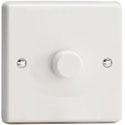Whether you’re a homeowner or manager of a hospitality premises, a darkened patio is wasted space. Good patio lighting makes a property more inviting, and is often an important facet of an entertainment venue. The patio may connect to a garden, or it may be a small garden in itself. Here we’ll show you how to use outdoor lights (and other tricks) to illuminate the various features of your patio, so you can reap the rewards of this valuable outdoor space.
But first… indoor dimming
It may seem an odd place to start, but dimming is useful if you want to enjoy outdoor lighting from the comfort of a living room, or conservatory. In restaurants and hotels, patrons may gaze out over a beautifully lit patio and garden during winter months. Indoor lighting that is too strong will cause excessive reflection and impair the outdoor view.
Lyco sells a range of dimmer switches, which help you balance indoor and outdoor illumination. Varilight models are exceptional for LED dimming. They also have a ‘soft start’ feature that reduces the chances of filament bulbs expiring in the cold.
Customised patio lighting
 Just like indoors, you should never over-light a patio or garden. Contrasting areas of light and dark create ambience and visual interest. Ground rules aside, various features of a patio might benefit from good lighting. Here are some examples:
Just like indoors, you should never over-light a patio or garden. Contrasting areas of light and dark create ambience and visual interest. Ground rules aside, various features of a patio might benefit from good lighting. Here are some examples:
Decking areas
These can be lit by walkover lights. Decking Lights serve this purpose. Discreet and durable, they are useful around the edges of a decking area for creating mood and adding an element of pedestrian safety.
Paved areas
Such areas can be installed with ground lights, like the Messina LED Ground Light from Searchlight. This can be safely walked over, and with an IP68 rating it tolerates immersion. The Messina is totally impervious to dust and torrential rain.
Low walls
Low walls are common around patio areas. Many ground lights are also suitable for embedding in walls, like the Stratford Recessed Square LED. Again, these are robustly weatherproof and provide excellent low-level lighting.

Flower borders and shrubbed areas
These areas are perfectly served by post lights. The Parma Post is one of many options here, with a black finish that blends well with green foliage.
Trees
Often a neighbouring feature of patios, they provide a good opportunity to create visual interest. Use a strong spotlight to dramatically light trees from below. Solar lights are excellent for this, since they’re self-sufficient and not tethered to a mains supply.
Statues and garden ornaments
These can be lit by the Deltech GL7 LED Spotlight. The GL7 comes with a ground spike and wall bracket, so is usable in numerous scenarios.
Trellises and gazebos
Such fixtures are ideal for fairy lights, which create restful but eye-catching illumination. The Solar Centre’s Everbright Solar Fairy Lights are usable all the year round. A built-in photocell automatically triggers these lights on and off at dusk and dawn. If you’re going for a party mood, colourful festoons are effective overhead or along a fence.
Exterior walls
Regularly overlooked, these offer a simple means of lighting a patio. Here we’re looking for something decorative as well as functional. The Iluzzia Outdoor Up Down Wall Light is economical and long lasting, water and dust resistant with a IP54 protection rating. In traditional vein, the Half Lantern from Selected By Lyco offers an equally durable solution.
For more inspiration, advice and news, visit our Lighting Advice section.

Andrew Evangelidis Head of Buying
Andrew is an experienced buying professional who takes an entrepreneurial approach to identify new lighting solutions and ensure Lyco have first-to-market ranges for our customers. Having previously worked for well known brands such as Wickes, Carphone Warehouse and Toys R Us, Andrew has now turned his hand to sourcing commercial lighting and ensure our customers receive top brand quality products at marketing leading prices. He manages a team of commercial and decorative buyers who travel the world finding new products that our customers don’t even know they need yet.








 The more sophisticated trailing-edge dimmer is intended for capacitive loads (e.g. electronic low-voltage transformers or LED drivers), and resistive loads (e.g. incandescent).
The more sophisticated trailing-edge dimmer is intended for capacitive loads (e.g. electronic low-voltage transformers or LED drivers), and resistive loads (e.g. incandescent).